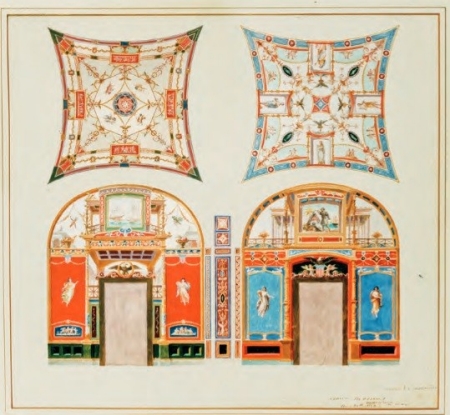Art historians have often regarded the Pompeian Revival as chiefly a European phenomenon, a feature of aristocratic residences, royal building projects, and the Crystal Palace at Sydenham, which had limited impact on the United States. Renovation and demolition have left few American Pompeian Revival spaces intact, but the sources I have compiled, including newspaper and magazine articles, archival photographs, personal correspondence, literary references, and advertisements, reveal that the style had many American advocates, interpreters, adopters, and detractors. Widespread components include strong colors (especially red, yellow, gold, and black), wall decoration in rectangular, monochrome fields with human (usually female) figures at the center, classical columns, furniture after the antique, and ancient (or ancient-looking) art objects. Fountains and pools, evocative of the water features prevalent in ancient courtyards, often completed the effect.
Although
During the Aesthetic Movement of the last third of the nineteenth century, the beautification of the American home became a topic of heightened national interest. Kristin Hoganson uses the phrase “cosmopolitan domesticity” to describe American tastemakers’ absorption of design elements from Japan, China, and the Middle East, along with historical and contemporary European styles. A middle-class parlor might display a mélange of decorative objects drawn from various traditions. The mansions of the wealthy, however, offered
The range of contemporary reactions evoked by the Pompeian style reflects national unease about the expansion of private wealth and luxury building projects during the Gilded Age and the years surrounding it. Whereas American enthusiasm for the Greek Revival style, bolstered by appreciation of the Greeks as noble democratic predecessors, had arisen from optimistic patriotism, suspicion of the Pompeian Revival style, fueled by conceptions of the ancient Pompeians as decadent, debauched, and destroyed, sprang from nagging fears that the United States, like the Roman Empire, would decline and fall. In periods of crisis, such as the years leading up to the Civil War, these fears became acute—as evidenced by the dismayed reactions to the Pompeian wall paintings of Constantino Brumidi (1805–1880) for the Naval Affairs Committee Room in the United States Capitol building, executed in the late 1850s. By bringing together examples of Pompeian rooms and the responses they evoked, I have been able to outline the significance of the style within American popular consciousness from the 1850s into the first decades of the twentieth century and to lay foundations for further investigations of the movement.
Members' Research Report Archive
The Pompeian Revival Style in the United States
Marden Fitzpatrick Nichols, The Walters Art Museum
A. W. Mellon Postdoctoral Fellow, 2010–2011
In my second year at CASVA, I continued to revise my book manuscript, “Vitruvius on Display: Domestic Decor and Roman Self-Fashioning at the End of the Republic,” to be published by Cambridge University Press and detailed in Center 31. I also pursued a second project, an investigation of the conventions and connotations of the so-called Pompeian (or Pompeian Revival) interior decoration popular in American houses, hotels, and other public spaces from the mid-nineteenth to the early twentieth century. Like my book on Vitruvius’ De architectura, this American study analyzes the material remains of architectural interiors together with contemporary texts across a range of genres. In both projects, I am interested in how associations develop around particular styles, and in the metonymic functions interior decor assumes in social, cultural, and political commentary.

Constantino Brumidi, design for frescoes in the Naval Affairs Committee Room (now the Senate Appropriations Conference Room), United States Capitol, 1856. Architect of the Capitol
- Vitruvius Pollio, Marcus
- Italian, - 1